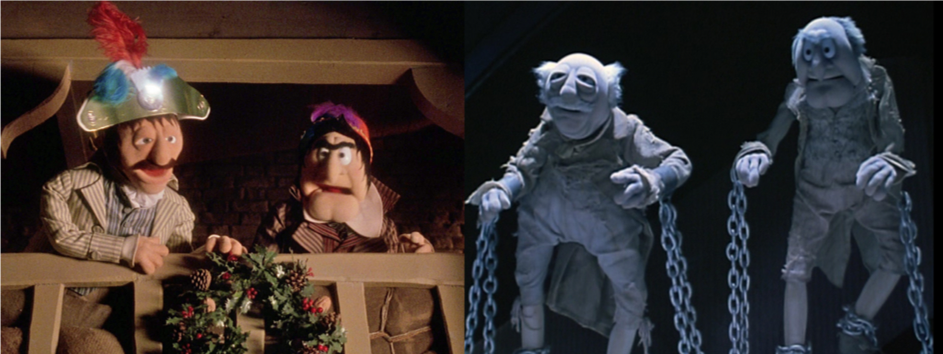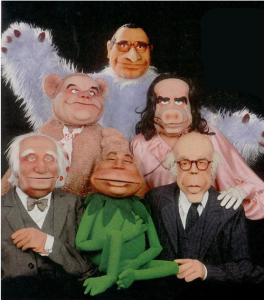After the end of World War II, in all the nations where television had a swift boom, puppets largely invaded the small screen to satisfy an increasingly younger audience eager for fantasy and adventure. While in the 1960s, live action dramaswere shot in cramped studios (which explains the abundance of medium long-shots trapped in a theatrical convention), programs using puppets allowed to obtain inexpensively the whole range of shots specific to high-budget fictions (i.e. extreme long, long, medium, full, close and extreme close shots).[1] Since the 1970s, the Jim Henson company extended this tradition by reaching all genres that puppets allowed: heroic and musical fantasies with The Dark Crystal (1982) and Labyrinth (1986), literature adaptations with The Muppet Christmas Carol (1992), Sci-Fi with Muppets from Space (1999), and so on. However, the most popular show remains The Muppet Show (1976-2015). In other words, Jim Henson’s puppet universe reached the greatest popularity through the most archaic filmic device he explored, namely filmed theatre plays.
In The Muppet Show, Jim Henson proposed an entertainment program that seems to take place in a theatre, as if the viewer would be sitting among the public[2]. In fact, the reverse shots show an audience hall populated only by puppets. In this way, Henson is constrained by theatrical conventions that require a frontal point of view and a limitation of shot scales. This option however offers many benefits like the possibility to hold the scene far from cinematographic realism (in a puppet booth, characters do not pretend to be living creatures), mix creatures made of foam and living actors (i.e. the guests), and give the occasion to shoot every scene in a studio (namely the A.T.V. Elstree Studios, North of London) optimized for set replacements and camera movements (which guarantees a regular performance). Yet, the main advantage is certainly the ability for recurrent puppets to perform in different roles, depending on the sketches they enlist in. Since we are clearly “in” a theater show, the audience can easily expect the “actors” to interpret different roles. Thus, even if the characters have their own personality, Fozzie Bear can easily become, in a single show, a surgeon, a pirate, a soldier or a magician, with a couple of accessories and a minimal disguise.
This condition may explain the success of the several movies featuring the Muppets. In The Muppet Christmas Carol, an adaptation of Charles Dicken’s Christmas Carol and the first feature film entirely directed by Henson Jr., the casting can rely on what we already know about the characters from the famous tv show. Thus, puppets can deploy new traits and become different characters: the candor and the devotion of the underpaid clerk Bob Cratchit naturally suits Kermit the frog, while the role of the damned Ebenezer Scrooge’s former business partners is perfect for the two cranky Statler and Waldorf (see Figure 1)[3].

© The Jim Henson company.
It is interesting to note that the film credits mention the original names of the puppets (those of the TV show) rather than those given by Charles Dickens in the original story (except for the supporting roles specially created for the film). In this film, like in The Muppet Show, humans cohabit with puppets (Scrooge is performed by Michael Caine), but puppets perform characters who celebrate the spirit of Christmas, while humans are linked to the only man who rejects it (i.e. Scrooge).
This gap is completely reversed in a very popular 1980s French show unambiguously inspired by The Muppet Show: the satirical Le Bébête show (The Beastie Show, 1988-1995) created by humorists Stéphane Collaro, Jean Roucas, and Jean Amadou. In it, the major French political figures were caricatured as the famous Jim Henson’s bestiary and the “bébêtes” (i.e. a pig, a frog, a bear, and so on) heckled and grouched behind a bar with the only sensible person of the show: the bartender (who represented the average Frenchman and was performed by the author of the show himself).
More precisely, in the early 1980s, Jean Roucas and his team watched The Muppet Show on TV when someone pushed on the mute button. Roucas, who was an imitator, started to speak on the Kermit score with the voice of the recently elected President François Mitterrand. The gag was so funny (Mitterrand could actually look like a frail frog) that they decided to test the same joke with other politicians on other Henson’s characters. Pleased by this good match, in 1982 the three famous stars of the National French TV channel TF1 decided to insert short sketches of “politicized” puppets commenting on the news in their anthology Coco-boy, a comical French TV program presented and directed by Stéphane Collaro. If up to 1984 these sketches kept being part of Coco-boy, from 1984 to 1987 they were inserted in another TF1 program, Cocoricocoboy. Finally, in 1988, in view of their success, these sketches were expanded to give life to Le Bébête show, a daily show composed only of them–certainly one of the most memorable French show using puppets.

Characters: Black Jack (Jacques Chirac turned into Gonzo the Great), Barzy (Raymond Barre as Fozzie bear), Marchie (Georges Marchais as Miss Piggy), Gaston (Gaston Defferre as Waldorf), Kermitterrand (François Mitterrand as Kermit the Frog), and Valéry Giscard-d’Estaing (Valy as Statler).
© TF1 Julia productions.
As for the theatrical films featuring the Muppets, the traits of the displayed characters could easily be assimilated by the audience to the well-known Henson’s creatures (see Figure 2). The most comical parody was Miss Piggy turned into the head of the French Communist Party Georges Marchais. The public could recognize the pork face, the pink dress, the flashy jewelry, the fingers always twisted in the hairs, but especially the tendency to bother the frog (“Kermitterrand”, a pun obtained merging the names “Kermit” and “Mitterrand”), his “best” rival. Furthermore, the tactical complicity between the former President, Valéry Giscard d’Estaing, and the Mayor of Marseille-city, Gaston Defferre, was mocked by the resemblance with the two elderly men on a balcony[4].
Unlike The Muppet Show, the scene did not take place in a theater but in a bar. This change offered at least three advantages: it allowed to ridicule the politicians (assimilated to drunkards), bring a “French touch” (Frenchmen used to parody themselves as “bons vivants”), and, technically, hide the puppeteers while framing the scene in the style of a theatre stage.
Gradually, the show got a larger audience and moved away from its original model (the late puppets no longer took root in Henson’s universe and their appearance became more and more human[5]) to reach the look of the British show Spitting Image and, after 1994, the French program Les Guignols de l’info. However, Le Bébête show reached its peak of popularity when the gap between referred and referent characters provided the greatest comic effects. It is undoubtedly due to the richness of the Henson’s universe that, thanks to the theatrical allusion, gave characters able to extend their quality to the limits of the parody. The audience, familiar with Jim Henson’s shows for a long time, could subsequently consider puppets as real actors, “able to perform” into several roles different from those assigned at the beginning. This flexibility helped to give depth to the character’s personality and may explain their success today, long after the end of the most popular programs where they “played.”
Samuel Kaczorowski is a French researcher in animation, director of animated films, associate professor of Applied Art affiliated to Tokyo Hosei (Japan) and Toulouse 2 Jean-Jaurès (France) Universities. His thesis was published in 2017 under the title Capter le moment fuyant – Osamu Tezuka et l’invention de l’animation télévisée. Today, both in his research and practice, he focuses on the depth in cel-animation and the Japanese puppetry on screen. In 2018, he started a program with a French Research Institutes Abroad (IFRE) affiliated to CNRS to study Oriental puppets (intersecting view between Middle and the Far East) focusing on the problem of archiving and conservation of puppets from television programs that are no longer on air.
[1] In Japan, puppets were largely used when the studios were unable to provide regular animation programs.
[2] In fact, the technicians can edit the show like in a normal pre-recorded program.
[3] In the original tale, Scrooge has only one partner: Jacob Marley. But, since the traits of Statler and Waldorf suited to the personality of the eager ghost, Brian Henson adapted the novel and created a duo.
[4] When Gaston Defferre died in 1986, the puppet of Giscard was redesigned into a new character that looks like a marabout.
[5] Since the 1990s, some new animals (e.g., Prime Minister Édith Cresson was a lioness) obscured the Muppet’s bestiary.

1 comment for “The French Reinterpretation of Jim Henson’s Muppet Universe”